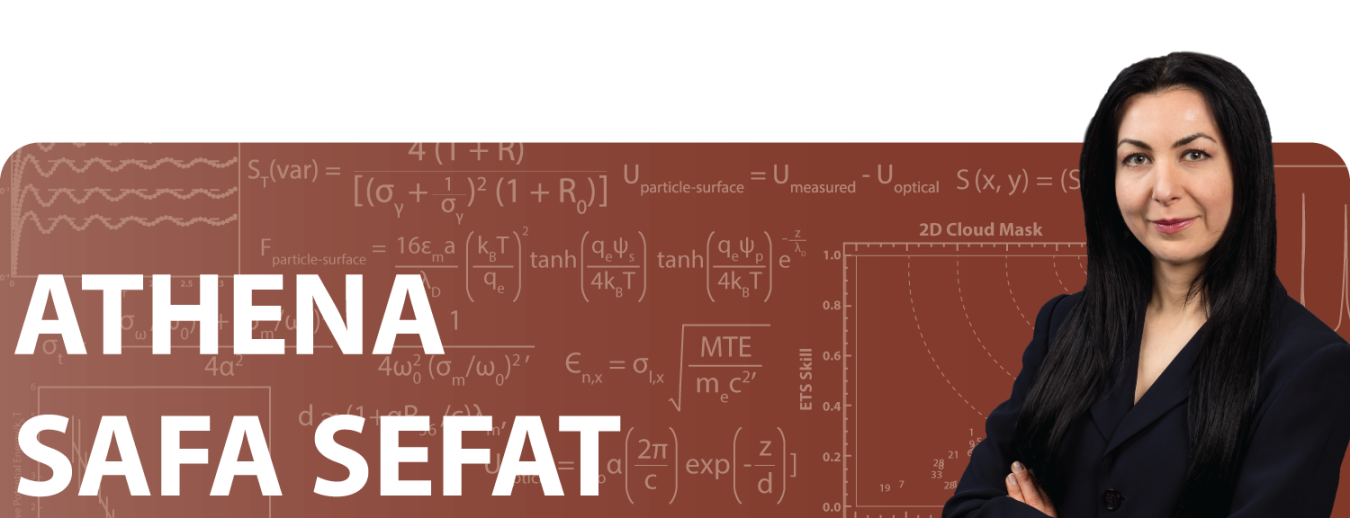Athena Safa Sefat focuses on superconductors to understand the design of quantum materials, to predict the next generation of materials.
June 19, 2020
WHAT DID THE 2010 EARLY CAREER AWARD ALLOW YOU TO DO?
The U.S. Department of Energy (DOE)’s Early Career Award (ECA) gave me the opportunity to manage my independent scientific research for five years, with the overall responsibility of planning and performing first-rate science. My ECA research broadly tackled one of the grand challenges of the Office of Science, Basic Energy Sciences (BES): to understand and enable the design of quantum materials for advancing and predicting the next generation of materials.
Quantum materials are complex in that electron and spin phenomena at atomic scales manifest in a collective ‘correlated’ property below a particular temperature. My research focused on a class of quantum materials called superconductors. These are materials that can carry large amounts of electricity without resistance – i.e., they have no unwanted energy loss through heating. My experiments established many crucial connections between quantum materials’ signature characteristics (e.g., structure types, elemental constituents, lattice parameters, carrier concentration, chemical or electronic order or inhomogeneity, defects) and superconductivity.
With more than 90 refereed publications and high-impact scientific highlights, my ECA research was featured at the 2015 BES Advisory Committee Meeting as a success story for the BES Materials Sciences and Engineering Division. The findings from this research could ultimately lead to the discovery of advanced superconductors with superior properties for technological applications.
ABOUT:
Athena Safa Sefat is a Senior Research Scientist and a former Wigner Fellow in the Materials Science & Technology Division of the Physical Sciences Directorate at Oak Ridge National Laboratory.
SUPPORTING THE DOE SC MISSION:
The Early Career Research Program provides financial support that is foundational to early career investigators, enabling them to define and direct independent research in areas important to DOE missions. The development of outstanding scientists and research leaders is of paramount importance to the Department of Energy Office of Science. By investing in the next generation of researchers, the Office of Science champions lifelong careers in discovery science.
For more information, please go to the Early Career Research Program.
THE 2010 PROJECT ABSTRACT:
Origin of Superconductivity in Structurally Layered Materials
The goal of this project is to understand the fundamental mechanisms that produce superconductivity at high temperatures in structurally layered materials. The work will be focused on materials design and synthesis but will also include significant efforts in theoretical calculations and neutron scattering. Superconducting materials have the potential to impact a variety of energy relevant technologies, including power generation and transmission, particularly if materials can be found that can carry more current and operate at higher temperatures. Ultimately this research could lead to the discovery of new superconductors with superior properties compared to current materials.
RESOURCES:
Sefat, A. S., Singh, D. J., “Chemistry and electronic structure of iron-based superconductors.” Materials Research Society Bulletin 36, 614 (2011). [DOI: 10.1557/mrs.2011.175]
Sefat, A. S., “Bulk synthesis of iron-based superconductors.” Current Opinion in Solid State & Materials Science 17, 59 (2013). [DOI: 10.1016/j.cossms.2013.04.001]
Gofryk, K., Pan, M., Cantoni, C., Saparov, B., Mitchell, J. E., Sefat, A. S., “Local inhomogeneity and filamentary superconductivity in Pr-Doped CaFe2As2.” Physical Review Letters 112, 047005 (2014). [DOI: 10.1103/PhysRevLett.112.047005]
DOE Explains… offers straightforward explanations of key words and concepts in fundamental science. It also describes how these concepts apply to the work that the Department of Energy’s Office of Science conducts as it helps the United States excel in research across the scientific spectrum. For more information on superconductivity and DOE’s research in this area, please go to “DOE Explains…Superconductivity.”
Additional profiles of the Early Career Research Program award recipients can be found on the Early Career Program Page.
The Office of Science is the single largest supporter of basic research in the physical sciences in the United States and is working to address some of the most pressing challenges of our time. For more information, please visit www.energy.gov/science.
Sandra Allen McLean

Sandra Allen McLean (sandra.mclean@science.doe.gov) is a communications specialist for the Office of Science in the Office of Communications and Public Affairs. Sandra is responsible for identifying, curating, or creating lay-language content about Office of Science-funded research for DOE web sites, popular and trade media, and stakeholder education. She researches and writes the historical Milestone Tweets for the office Twitter account @DOEScience.
Sandra holds an associate degree in American Sign Language interpreting, a bachelor’s in science journalism and biology, and a master’s in Information Sciences. Her hobbies are sewing – especially costumes! – and lesesucht, compounded by extreme tsundoku.


